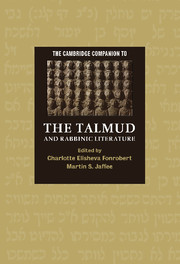Book contents
- Frontmatter
- Introduction: The Talmud, Rabbinic Literature, and Jewish Culture
- Part I: The Conditions of Rabbinic Literary Activity
- 1 Rabbinic Authorship as a Collective Enterprise
- 2 The Orality of Rabbinic Writing
- 3 Social and Institutional Settings of Rabbinic Literature
- 4 The Political Geography of Rabbinic Texts
- Part II: The Genres of Rabbinic Literary Composition
- Part III: Hermeneutical Frames for Interpreting Rabbinic Literature
- Bibliography
- Index
- Source Index
- Series List
4 - The Political Geography of Rabbinic Texts
from Part I: - The Conditions of Rabbinic Literary Activity
Published online by Cambridge University Press: 28 November 2007
- Frontmatter
- Introduction: The Talmud, Rabbinic Literature, and Jewish Culture
- Part I: The Conditions of Rabbinic Literary Activity
- 1 Rabbinic Authorship as a Collective Enterprise
- 2 The Orality of Rabbinic Writing
- 3 Social and Institutional Settings of Rabbinic Literature
- 4 The Political Geography of Rabbinic Texts
- Part II: The Genres of Rabbinic Literary Composition
- Part III: Hermeneutical Frames for Interpreting Rabbinic Literature
- Bibliography
- Index
- Source Index
- Series List
Summary
It is impossible to draw any simple causal connections between the characteristics of the various rabbinic corpora and the political environments in which they were produced. There is no way to argue convincingly, for example, that the structure (as opposed to some of the content) of the Mishnah and Tosefta reflect in some discernible way the conditions of the High Roman imperial East, or that the Bavli owes its compendious, generically composite, character to the conditions of the Sasanian west.
One reason for this is the state of our knowledge: Even in the case of the Palestinian documents, whose Roman political context is in fact quite well known (Sasanian history, by contrast, is very poorly understood), we are nearly completely ignorant of the circumstances in which the texts were produced. Rabbinic literature itself identifies the editors of some of the texts but - apart from the fact that these identifications are questionable - it reports next to nothing about the ways the editors worked (we may contrast the abundant contemporary information about the production of the Theodosian Code). In the cases of some of the midrash collections and the Bavli, even the approximate dating of redaction is highly controversial, and the datings of the other corpora are perhaps not as controversial as they should be.
There are more profound reasons for our inconclusiveness: The relation between any literary artifact and the political, cultural, and social circumstances in which it was produced can only ever be oblique and complex, in any case certainly resistant to comprehensive description. But our inability to provide a full account does not absolve us from the responsibility for attempting a partial one.
- Type
- Chapter
- Information
- Publisher: Cambridge University PressPrint publication year: 2007
- 5
- Cited by

